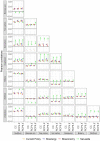More future synergies and less trade-offs between forest ecosystem services with natural climate solutions instead of bioeconomy solutions
- PMID: 35949042
- PMCID: PMC9805065
- DOI: 10.1111/gcb.16364
More future synergies and less trade-offs between forest ecosystem services with natural climate solutions instead of bioeconomy solutions
Abstract
To reach the Paris Agreement, societies need to increase the global terrestrial carbon sink. There are many climate change mitigation solutions (CCMS) for forests, including increasing bioenergy, bioeconomy, and protection. Bioenergy and bioeconomy solutions use climate-smart, intensive management to generate high quantities of bioenergy and bioproducts. Protection of (semi-)natural forests is a major component of "natural climate solution" (NCS) since forests store carbon in standing biomass and soil. Furthermore, protected forests provide more habitat for biodiversity and non-wood ecosystem services (ES). We investigated the impacts of different CCMS and climate scenarios, jointly or in isolation, on future wood ES, non-wood ES, and regulating ES for a major wood provider for the international market. Specifically, we projected future ES given by three CCMS scenarios for Sweden 2020-2100. In the long term, fulfilling the increasing wood demand through bioenergy and bioeconomy solutions will decrease ES multifunctionality, but the increased stand age and wood stocks induced by rising greenhouse gas (GHG) concentrations will partially offset these negative effects. Adopting bioenergy and bioeconomy solutions will have a greater negative impact on ES supply than adopting NCS. Bioenergy or bioeconomy solutions, as well as increasing GHG emissions, will reduce synergies and increase trade-offs in ES. NCS, by contrast, increases the supply of multiple ES in synergy, even transforming current ES trade-offs into future synergies. Moreover, NCS can be considered an adaptation measure to offset negative climate change effects on the future supplies of non-wood ES. In boreal countries around the world, forestry strategies that integrate NCS more deeply are crucial to ensure a synergistic supply of multiple ES.
Keywords: EU biodiversity strategy; EU forest strategy; GLOBIOM; bioeconomy; bioenergy; boreal forest; climate change; ecosystem services; natural climate solutions.
© 2022 The Authors. Global Change Biology published by John Wiley & Sons Ltd.
Conflict of interest statement
There are no potential conflicts of interest.
Figures




Similar articles
-
Reconciling the EU forest, biodiversity, and climate strategies.Glob Chang Biol. 2024 Aug;30(8):e17431. doi: 10.1111/gcb.17431. Glob Chang Biol. 2024. PMID: 39092769
-
Does increasing forest age lead to greater trade-offs in ecosystem services? A study of a Robinia pseudoacacia artificial forest on the Loess Plateau, China.Sci Total Environ. 2024 May 20;926:171737. doi: 10.1016/j.scitotenv.2024.171737. Epub 2024 Mar 18. Sci Total Environ. 2024. PMID: 38508272
-
A synthesis of current knowledge on forests and carbon storage in the United States.Ecol Appl. 2011 Sep;21(6):1902-24. doi: 10.1890/10-0697.1. Ecol Appl. 2011. PMID: 21939033
-
Climate change adaptation and mitigation strategies for production forests: Trade-offs, synergies, and uncertainties in biodiversity and ecosystem services delivery in Northern Europe.Ambio. 2024 Jan;53(1):1-16. doi: 10.1007/s13280-023-01909-1. Epub 2023 Aug 17. Ambio. 2024. PMID: 37592197 Free PMC article. Review.
-
Transitional forestry in New Zealand: re-evaluating the design and management of forest systems through the lens of forest purpose.Biol Rev Camb Philos Soc. 2023 Aug;98(4):1003-1015. doi: 10.1111/brv.12941. Epub 2023 Feb 19. Biol Rev Camb Philos Soc. 2023. PMID: 36808687 Review.
Cited by
-
Environmental problem shifting from climate change mitigation: A mapping review.PNAS Nexus. 2023 Dec 19;3(1):pgad448. doi: 10.1093/pnasnexus/pgad448. eCollection 2024 Jan. PNAS Nexus. 2023. PMID: 38205028 Free PMC article. Review.
-
MultiOptForest: An interactive multi-objective optimization tool for forest planning and scenario analysis.Open Res Eur. 2024 Dec 16;3:103. doi: 10.12688/openreseurope.15812.2. eCollection 2023. Open Res Eur. 2024. PMID: 39931429 Free PMC article.
-
Assessing the Potential Distribution of Pseudoechthistatus (Coleoptera: Cerambycidae) in China Under Climate Change Using Species Distribution Models.Ecol Evol. 2025 Apr 14;15(4):e71303. doi: 10.1002/ece3.71303. eCollection 2025 Apr. Ecol Evol. 2025. PMID: 40230865 Free PMC article.
-
Using Ecological Modeling to Study the Response of Distribution Dynamics of Paraglenea fortunei (Coleoptera: Cerambycidae) to Human Activities and Climate Change to in Northeast Asia.Ecol Evol. 2025 Jul 8;15(7):e71782. doi: 10.1002/ece3.71782. eCollection 2025 Jul. Ecol Evol. 2025. PMID: 40635791 Free PMC article.
References
-
- Alcamo, J. , van Vuuren, D. , Ringler, C. , Cramer, W. , Masui, T. , Alder, J. , & Schulze, K. (2005). Changes in nature's balance sheet: Model‐based estimates of future worldwide ecosystem services. Ecology and Society, 10(2), 27.
-
- Alrahahleh, L. , Ikonen, V. P. , Kilpeläinen, A. , Torssonen, P. , Strandman, H. , Asikainen, A. , Kaurola, J. , Venäläinen, A. , & Peltola, H. (2017). Effects of forest conservation and management on volume growth, harvested amount of timber, carbon stock, and amount of deadwood in Finnish boreal forests under changing climate. Canadian Journal of Forest Research, 47(2), 215–225.
-
- Anderson, R. C. , Loucks, O. L. , & Swain, A. M. (1969). Herbaceous response to canopy cover, light intensity, and throughfall precipitation in coniferous forests. Ecology, 50(2), 255–263.
-
- Augustynczik, A. L. D. , & Yousefpour, R. (2021). Assessing the synergistic value of ecosystem services in European beech forests. Ecosystem Services, 49, 101264.
MeSH terms
Substances
LinkOut - more resources
Full Text Sources
Other Literature Sources

